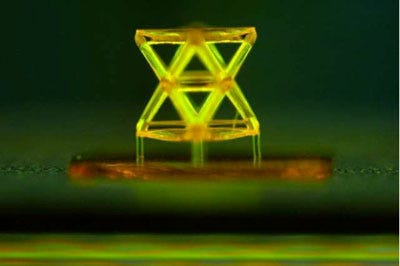3-D Printing Creates Ultralight, Ultrastiff Nanoscale Geometry
June 25, 2014
A high-precision 3-D printing process called projection microstereolithography has been employed by engineers at the Massachusetts Institute of Technology (MIT) and Lawrence Livermore National Laboratory (LLNL) to construct microlattices with nanoscale features that combine great stiffness and strength with ultralow density.
The new design, which may set new records for stiffness for a given weight, is called a stretch-dominated octet truss unit. The development is described in "Ultralight, Ultrastiff Mechanical Metamaterials," published in the journal Science. The research team included MIT's Nicholas Fang; former postdoc Howon Lee, now an assistant professor at Rutgers University; visiting research fellow Qi "Kevin" Ge; LLNL's Christopher Spadaccini and Xiaoyu "Rayne" Zheng; and eight others.
|
A single stretch-dominated octet truss unit created with microstereolithography (Courtesy Zheng, et al.) |
Normally, Fang explains, stiffness and strength decline as the density of a material decreases. But by using the right mathematically determined structures to distribute and direct the loads, the way the arrangement of vertical, horizontal, and diagonal beams do in the Eiffel Tower, a lighter structure can maintain its strength.
The geometric basis for such microstructures was determined more than a decade ago, Fang says, but it took years to transfer that mathematical understanding "to something we can print, using a digital projection -- to convert this solid model on paper to something we can hold in our hand." The result was "a pleasant surprise to us," he adds, performing even better than anticipated.
According to Zheng, "A stretch-dominated unit cell structure...is substantially more mechanically efficient--with a higher stiffness-to-weight ratio...than its bend-dominated counterpart. This is attributed to its struts carrying load under compression or tension rather than bending. The cell has a regular octahedron as its core, surrounded by eight regular tetrahedra distributed on its faces. All the strut elements have identical aspect ratios, with 12 solid rods or hollow tubes connected at each node."
Refresh your medical device industry knowledge at MEDevice San Diego, September 10-11, 2014. |
The Department of Defense's Defense Advanced Research Projects Agency (DARPA) and Lawrence Livermore's Laboratory Directed Research and Development (LDRD) program funded the team's research.
Stephen Levy is a contributor to Qmed and MPMN.
About the Author(s)
You May Also Like



.png?width=300&auto=webp&quality=80&disable=upscale)